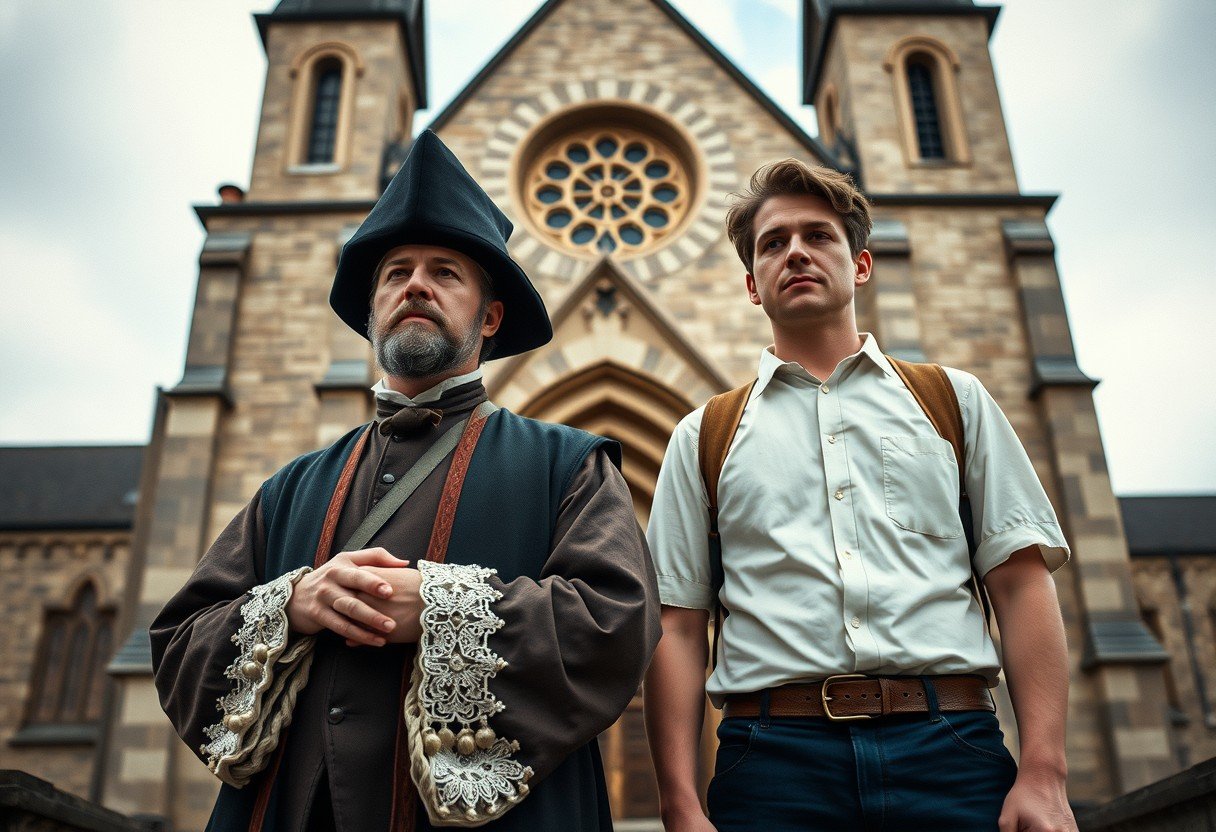During the 18th-century religious revivals in America, a major split occurred within Protestantism, creating two distinct groups known as the Old Lights and New Lights. While both followed Protestant beliefs, their approaches to faith, worship, and scripture created a fascinating divide. This split happened during a period of intense spiritual fervor called the Great Awakening, and understanding these differences helps explain the evolution of American Christianity and the diverse forms of worship we see today.
The Historical Stage for a Religious Divide
To understand the Old and New Lights, we first have to look back to the 16th-century Protestant Reformation. This was a time of huge change in Europe when leaders like Martin Luther and John Calvin challenged the authority and practices of the Catholic Church. They wanted to bring Christianity back to its roots, focusing on the Bible and a personal relationship with God.
This movement emphasized salvation through faith alone, not by purchasing forgiveness or following rigid church rules. Figures like Martin Luther, who famously posted his 95 Theses, made the Bible accessible to ordinary people by translating it into common languages. This empowered individuals to read and interpret scripture for themselves, laying the groundwork for future debates about faith and practice.
By the time Protestantism reached the American colonies, this spirit of reform and individual interpretation was deeply ingrained. It created an environment where new ideas about worship and personal experience could flourish, eventually leading to the clash between the Old Lights and New Lights.
Defining the Old Lights and New Lights
The terms “Old Lights” and “New Lights” came into use during the First Great Awakening, a series of religious revivals that swept through the American colonies in the 1730s and 1740s. These labels helped people describe the two opposing sides of the movement.
Old Lights were the traditionalists. They belonged to the established Protestant churches, like the Congregationalists and Anglicans, and preferred order, reason, and formal worship. They believed that a calm, educated approach to faith was the best way to honor God. They were often skeptical of the emotional outbursts seen in revival meetings.
In contrast, New Lights were the revivalists. They embraced the emotional side of religion and believed that a true Christian must have a personal, heartfelt conversion experience. Preachers like George Whitefield and Jonathan Edwards were leading New Lights who delivered passionate sermons that stirred deep emotions in their listeners. They focused on the idea that anyone could have a direct connection with God, regardless of their education or social status.
Core Theological Disagreements
While both groups were Protestant, their core beliefs on key issues differed significantly. These disagreements were not just about style; they were about the very nature of salvation and how one should read the Bible.
Old Lights often held a more traditional view of salvation, sometimes leaning towards the idea of predestination, where God has already chosen who will be saved. New Lights, however, preached that salvation was available to everyone who genuinely sought it through a personal conversion. They emphasized individual agency and the emotional experience of being “born again.”
Their approaches to scripture also varied. Old Lights favored a scholarly and literal interpretation, relying on educated ministers to explain the Bible’s meaning. New Lights encouraged a more personal and experiential reading, where the Holy Spirit could reveal the scripture’s truth to any believer.
| Aspect | Old Lights View | New Lights View |
|---|---|---|
| Worship Style | Formal, structured, and rational | Emotional, spontaneous, and personal |
| Sermons | Theologically dense and reasoned | Passionate, persuasive, and dramatic |
| Salvation | Emphasized doctrine and predestination | Focused on personal conversion experience |
| Clergy | Formal education was essential | A personal “calling” was more important |
Contrasting Styles of Worship and Preaching
The most visible difference between Old Lights and New Lights was in their worship services. An Old Lights church service was predictable and orderly. It followed a set liturgy with formal prayers, traditional hymns, and a long, scholarly sermon designed to teach moral and theological lessons.
New Lights meetings, on the other hand, were dynamic and often unpredictable. They were known for their revivalist fervor, which could happen in churches, tents, or even open fields. These gatherings were designed to evoke a strong emotional response from the audience.
Key features of their worship styles included:
- Old Lights: They valued reverence and decorum. Their services were designed to cultivate spiritual discipline and respect for church authority.
- New Lights: They encouraged passionate expressions of faith, such as crying, shouting, and fainting. They used contemporary music and personal testimonies to make worship more engaging and accessible.
This revolutionary approach to worship appealed to a much broader audience than traditional church services could. By prioritizing personal experience, New Lights made religion feel more immediate and relevant to the lives of ordinary people.
Lasting Impact on American Christianity
The divide between Old Lights and New Lights had a profound and lasting impact on religion in America. The New Lights’ emphasis on personal experience and emotional faith fueled the growth of evangelical denominations like the Baptists and Methodists, which became major forces in American religious life.
The First Great Awakening, and later the Second Great Awakening in the early 19th century, changed the religious landscape forever. These movements promoted a more democratic form of Christianity, where individual conscience was valued over established church authority. This focus on individualism resonated with the broader political changes happening in the colonies, which would eventually lead to the American Revolution.
Ultimately, the tension between the rationalism of the Old Lights and the emotionalism of the New Lights created a dynamic that continues to shape American Protestantism. It established a tradition of religious innovation and diversity that remains a hallmark of faith in the United States today.
Frequently Asked Questions
What is the main difference between Old Lights and New Lights?
The main difference lies in their approach to worship and religious experience. Old Lights favored traditional, rational, and structured services, while New Lights championed emotional, experiential faith centered on personal conversion.
Who were some famous New Light preachers?
Famous New Light preachers include George Whitefield, known for his dramatic open-air sermons, and Jonathan Edwards, whose sermon “Sinners in the Hands of an Angry God” is a classic example of revivalist preaching.
Did the Old Lights oppose the Great Awakening?
Yes, many Old Lights were critical of the Great Awakening. They viewed the emotionalism and spontaneity of the revivals as chaotic and theologically shallow, fearing it would undermine church order and authority.
How did the New Lights change American religion?
The New Lights significantly impacted American religion by promoting evangelicalism and the importance of a personal relationship with God. Their revivalist methods led to the growth of new denominations and fostered a more democratic and individualistic religious culture.
Are there still Old Lights and New Lights today?
While the specific terms are historical, the underlying tension between traditional, liturgical worship (Old Light style) and charismatic, experiential worship (New Light style) still exists in many Protestant denominations today.






Leave a Comment